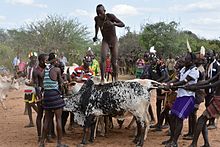Hamar people (original) (raw)
From Wikipedia, the free encyclopedia
Omotic language-speaking ethnic group in southwestern Ethiopia
Ethnic group
Hamer
 |
|---|
| Total population |
| 46,532 |
| Regions with significant populations |
 South Ethiopia Regional State South Ethiopia Regional State |
| Languages |
| Hamer |
| Religion |
| Animism |
The Hamar people (also spelled Hamer) are a community inhabiting southwestern Ethiopia. They live in Hamer woreda (or district), a fertile part of the Omo River valley, in the Debub Omo Zone of the former South Ethiopia Regional State (SERS). They are largely pastoralists, so their culture places a high value on cattle.
The 2007 national census reported 46,532 people in this ethnic group, of whom 10,000 were urban inhabitants. The vast majority (99.13%) live in the SNNPR.[1]
According to the Ethiopian national census of 1994, there were 42,838 Hamer language speakers, and 42,448 self-identified Hamer people, representing approximately 0.1% of the total Ethiopian population.[2]
Bull-jumping ceremony
The Hamar are known for their unique custom of "bull jumping," which initiates a boy into manhood. First, female relatives dance and invite whipping from men who have recently been initiated; this shows their support of the initiate, and their scars give them a say on whom they marry.
The boy must run back and forth twice across the backs of a row of bulls or castrated steers, and is ridiculed if he fails.[3]
The men of the tribe will often style their hair with clay, creating a sculpture of sorts that is styled with various pigments, mostly red and white, and in smoothing the clay they create very small protruding tube in which they house ostrich feathers from their hunts.
The Assistant Administrator of Hamer Bena, Ato Imnet Gashab, has commented that only seven tribal members have ever completed secondary education.
Hamer decoration
Collars for Hamer married women
Mingi, in the religion of the Hamar and related tribes, is the state of being impure or "ritually polluted".[4] A person, often a child, who was considered mingi is killed by forced permanent separation from the tribe by being left alone in the jungle or by drowning in the river.[5]
- ^ 2007 Ethiopian census, first draft Archived 4 June 2012 at the Wayback Machine, Ethiopian Central Statistical Agency (accessed 6 May 2009)
- ^ Hudson, Grover. 75 Ethiopian Languages: 19 Cushitic, 20 Nilosaharan, 23 Omotic, 12 Semitic, and 1 Unclassified, 2005.
- ^ Wharton, Jane (22 February 2015). "The making of a man: Inside a bull jumping ceremony with Ethiopia's Hamer tribe". Express (London). Retrieved 8 March 2016.
- ^ Do the Hamar have a Concept of Honor?, Ivo Strecker, University of Mainz, "Archived copy" (PDF). Archived from the original (PDF) on 25 July 2011. Retrieved 19 February 2010.
{{[cite web](/wiki/Template:Cite%5Fweb "Template:Cite web")}}: CS1 maint: archived copy as title (link) - ^ "The Hamar and Karo Tribes: The Search for Mingi". Films Media Group. Retrieved 20 November 2019.
- Lydall, Jean, and Ivo Strecker (1979). The Hamar of Southern Ethiopia. In three volumes: v. 1.: Work journal; v. 2: Baldambe explains; v. 3: Conversations in Dambaiti. Arbeiten aus dem Institut fur Volkerkunde der Universitat zu Göttingen, Bd. 12–14. Hohenschaftlarn: Klaus Renner Verlag. ISBN 3-87673-063-5 (v. 1); ISBN 3-87673-064-3 (v. 2); ISBN 3-87673-065-1 (v. 3).
- Giansanti, Gianni (2004). Vanishing Africa. Text and photographs by Gianni Giansanti; ethnographic introductions by Paolo Novaresio. Translated from Italian. With audio CD. Vercelli, Italy: White Star. ISBN 88-544-0006-8.
- Strecker, Ivo A. (1988). The Social Practice of Symbolization: An Anthropological Analysis. Monographs on Social Anthropology, no. 60. London; Atlantic Highlands, New Jersey: Athlone Press. ISBN 0-485-19557-7.
- 1973 – Rivers of Sand by Robert Gardner color, 83 min
- 1994 – Sweet Sorghum: An Ethnographer's Daughter Remembers Life in Hamar, Southern Ethiopia: a film by Ivo Strecker and Jean Lydall and their daughter Kaira Strecker. A production of IWF. Watertown, Massachusetts: Documentary Educational Resources, [released c. 1997]. VHS. Presenter/narrator, Kaira Strecker; producer, Rolf Husmann.
- 1996 release – "The Hamar Trilogy." A series of three films by Joanna Head and Jean Lydell; distributed by Filmakers Library, NYC. Titles in the series are: The Women Who Smile, Two Girls Go Hunting and Our Way of Loving.
- 2001 – Duka's Dilemma: A Visit to Hamar, Southern Ethiopia. A film by Jean Lydall and Kaira Strecker. Watertown, Massachusetts: Documentary Educational Resources, released in 2004. DVD. Camera, sound, and editing, Kaira Strecker; anthropology and production, Jean Lydall.
- 2001 – The Last Warriors: The Hamar and Karo Tribes: Searching for Mingi. A Trans Media production; Southern Star. Princeton, New Jersey: Films for the Humanities & Sciences. VHS. From The Last Warriors: Seven Tribes on the Verge of Extinction. Series producer/executive producer, Michael Willesee Jr.; writer/director, Ben Ulm. ISBN 0-7365-3606-X.
- 2003 – Nyabole: Hamar – Southern Ethiopia. CD. Museum collection Berlin series. Recorded between 1770 and 1776 and originally published on LP 1768. Mainz, Germany: Wergo.
 Media related to Hamar people at Wikimedia Commons
Media related to Hamar people at Wikimedia Commons
- The Hamar People of the Omo Valley, also known as the Hamer People
- Hamer page from BBC
- People of Africa
- Discovery channel
- Video of Hamer village market – YouTube
- Video of bull jumping – YouTube
- Photos taken of members of the Hamar tribe, February 2010
- Hamer and people of Omo Valley (Photos from Jean Buet) Archived 22 December 2014 at the Wayback Machine


